DAWN 11/15
A game of strategy for two players,
on the current asteroid mission of NASA.
Game design by Ingo Althöfer; Copyright July 2007, updated April 2019.
Contact: 3-hirn "at" althofer.de
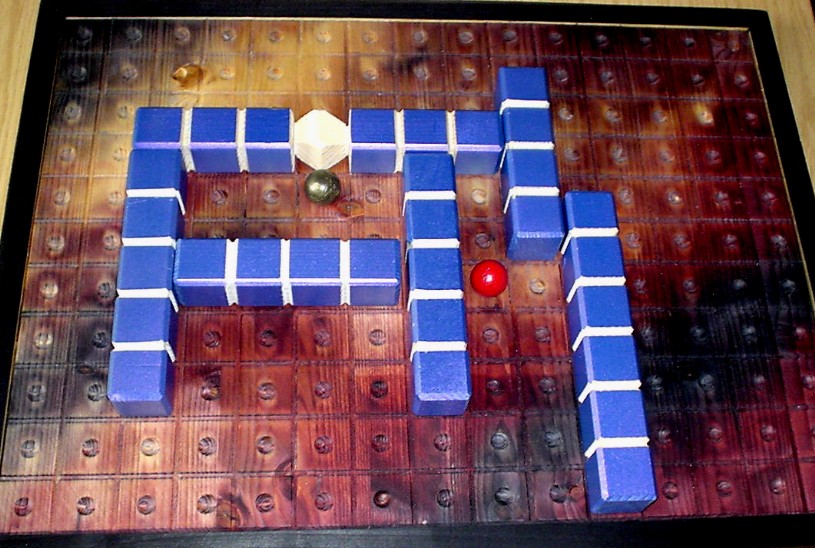
Story
Vesta and Ceres are two icons of the asteroid belt.
On September 27, 2007, the space probe DAWN was
started from Cape Canaveral. DAWN is intended to
arrive at asteroid No.4 Vesta in August 2011, making
science there for about eight months, and then flying
on to dwarf planet (and asteroid No.1) Ceres. Arrival
at Ceres is scheduled for February 2015, and there
another science period of several months is planned.
In the game, the two players are "Nature" and
"Mission
Control". Nature is driving the asteroids, whereas
Mission Control tries to advance science by fixing the
asteroids. So, a sort of divide-and-conquer duel is
played, with rather asymmetric roles for the players.
Game consists of:
A rectangular playing board, two balls representing
Vesta and Ceres, 2 x 6 bars, a special six-sided die.
The board has 11 x 15 squares. The two asteroids
"Vesta" (in red) und "Ceres" (brownish) obey player
Nature. Player "Mission Control" controls two sets
of six bars each, with lengths 2, 3, 4, 5, 6, and 7.
The bars of length 7 have a special shape, inspired
by the shape of the DAWN probe. The die carries the
symbols 2, 3, 4, 5, 6, and DAWN on its six faces.
Preparation
The board is placed flatly on the table. In the
beginning, it is completely empty. The two players
negotiate who takes the roles of Nature and
Mission Control in game 1. Nature gets the
asteroids and the die, and puts Ceres aside for the
time being.
Mission Control gets all twelve bars and sorts the two
sets apart. One set, consisting of one bar for each
length 2, 3, 4, 5, 6, 7, will be used in Phase 1.
The other set is meant for the second phase.
Start of the Game: Vesta shows up
Nature enters the asteroid Vesta on any square of the board.
Phase 1: Hunting Vesta
This phase consists of six rounds. Each round includes
three actions (a), (b), (c) which are executed one after
the other:
(a) Nature rolls the die.
(b) Mission Control places a "new" bar of appropriate
length on the board.
(c) Nature moves Vesta by "some" elementary steps. The
maximum number of steps is given by the length of the
bar just inserted by Mission Control.
On (a):
The symbol DAWN on the die stands for length 7.
On (b):
When the die shows a number whose bar has not been
inserted yet, exactly this bar is to be placed by
Mission Control. However, if this bar is "in" already,
from the set of remaining bars the next smaller length
or the next larger length has to be inserted.
Example: 4 has been rolled, but only the bars of
lenghts 3, 6, 7 are still available. Then either the 3-bar
(next smaller) or the 6-bar (next larger) may be inserted.
By the way, in round 6 only one "new" bar remains. So, it
is in principle superfluous to roll the die in this round.
A bar may be placed only on free parts of the board, in
one of the following three orientations: vertically flat,
horizontally flat, or upright. In the two "flat" orientations
the number of squares needed is just the bar's length.
In case of "upright" orientation this bar occupies exactly
one square of the board.
One special rule holds for the DAWN-bar (with length 7):
it is allowed to jut out at a boundary of the board (see
picture).
On (c):
A movement of Vesta consists of a sequence of elementary
steps. Each elementary step goes one square in orthogonal
direction (either to the north, to the east, to the south,
or to the west) on a free square. Elementary steps in
diagonal direction are not allowed. The length of the bar
just entered in (b) prescribes the maximum number of
elementary steps. However, Nature is free to make less
steps. Especially, remaining on its square without movement
is also allowed.
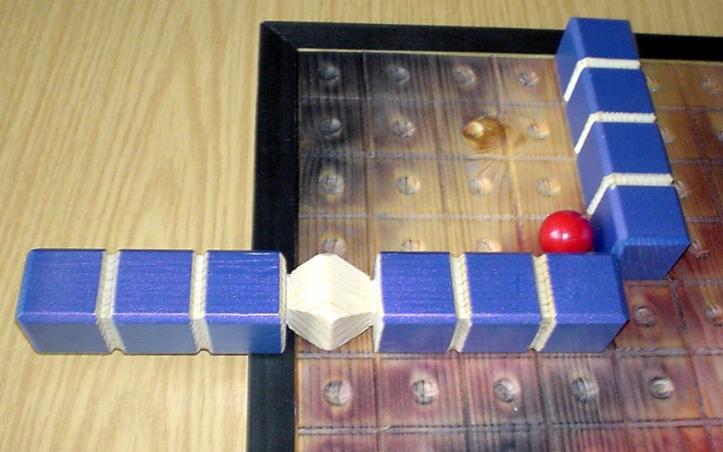 The DAWN bar is jutting out (Other bars are not
allowed to do so.)
The DAWN bar is jutting out (Other bars are not
allowed to do so.)
Interlude: Ceres comes in
After Phase 1 is finished, Nature places Ceres on
any free square of the board. Vesta and all the bars
from Phase 1 remain on their positions.
Phase 2: Hunting Vesta (immobile now) and Ceres (mobile)
This phase consists of six rounds, too. Each round again
has three actions (a), (b), (c) which are executed one
after the other.
(a) Nature rolls the die.
(b) Mission Control places a "new" bar of appropriate
length on the board.
(c) Nature moves Ceres by "some" elementary steps. The
maximum number of steps is given by the length of the bar
just inserted by Mission Control.
For (a), (b), and (c), the explanations from Phase 1 hold.
In addition, the following rules concern (c): Ceres is not
allowed to move above Vesta. Vesta is totally immobile in
Phase 2.
Counting: How much Freedom is left for the Asteroids?
First of all the players determine how many free squares
still can be reached by Ceres in elementary steps, without
climbing above Vesta or above any bars. This number is
called F(C).
Analogously, it is determined how many free squares still
can be reached by Vesta without climbing above Ceres or
above any bars. This number is called F(V).
These two values are combined in a slightly strange way:
the larger one of F(C) and F(V) is taken plus the difference
between them. In formulae:
Result = max {F(C), F(V)} + [ max{F(C), F(V)} - min{F(C), F(V)} ]
or in short: Result = max + (max - min).
Two Examples on Computing F(C) and F(V):
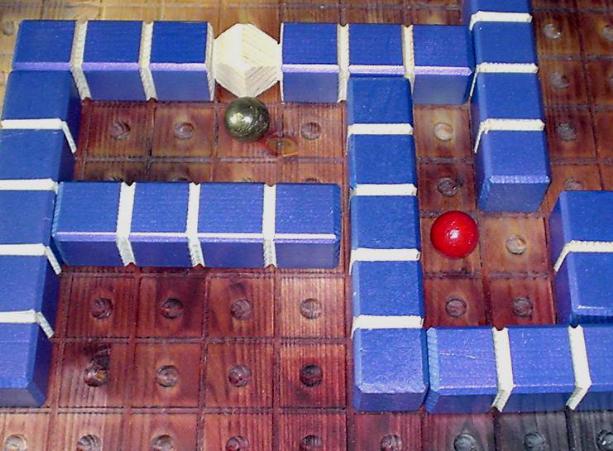
Here F(C)=7, F(V)=5.
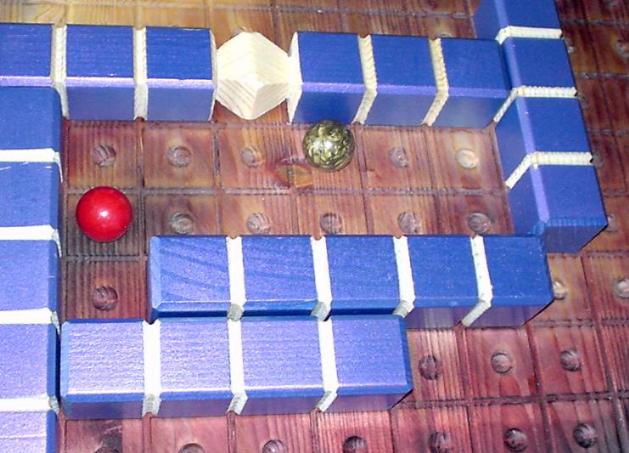
Here F(C)=10, F(V)=11.
Ceres and Vesta share 10 free squares. There is one
additional free square, reachable only for Vesta.
Examples on Computing the Result:
F(C)=7 and F(V)=5 give result 7 + (7-5) = 9.
F(C)=10 and F(V)=11 give result 11 + (11-10) = 12.
F(C)=8 and F(V)=8 give result 8 + (8-8) = 8.
F(C)=0 and F(V)=6 give result 6 + (6-0) = 12.
Typical scores for single games are between 3 and 18.
The result of the first game is noted. Then a second
game is played with roles interchanged. Overall winner is
the player who has the better score in comparison.
Some Hints for Strategy
* Vesta should be inserted on a more or less central square.
* After Phase 1 the board has already some divide-and-conquer
structure by the bars from the first set. Nature should put
Ceres in one of the larger compartments.
* Sometimes Nature should try to provoke situations where in the
endgame the bars of Mission Control are too long to be good
blockers.
* Mission Control should reach for two things: limiting the
freedom of Vesta and Ceres, and doing this in a way
as balanced as possible.
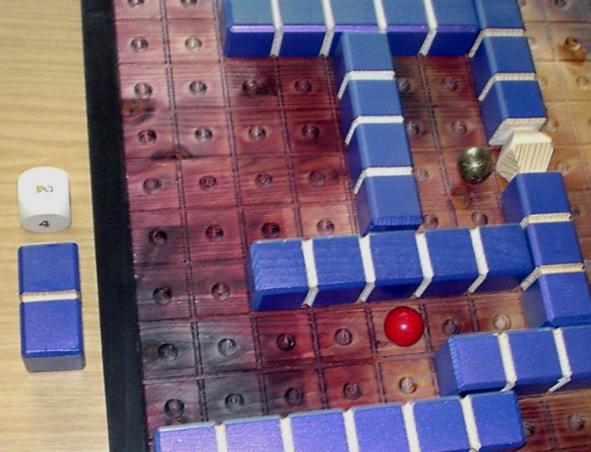
Question: When the 2-bar is the very last one to be
entered: where should Mission Control place it?
Contributions welcome
Probably skilled players will soon find better and more
sophisticated hints. Feedback with sketchy comments (and notations
of nice games) is very welcome, at the email address given in the
head of the rules.
References
* This rule can be found at
http://www.althofer.de/dawn-11-15.html
* Astrophysicists Dr. Freimut Börngen (left) and
Dr. Johann Dorschner (right), both from Thuringia,
were the actors in the premiere of the game.
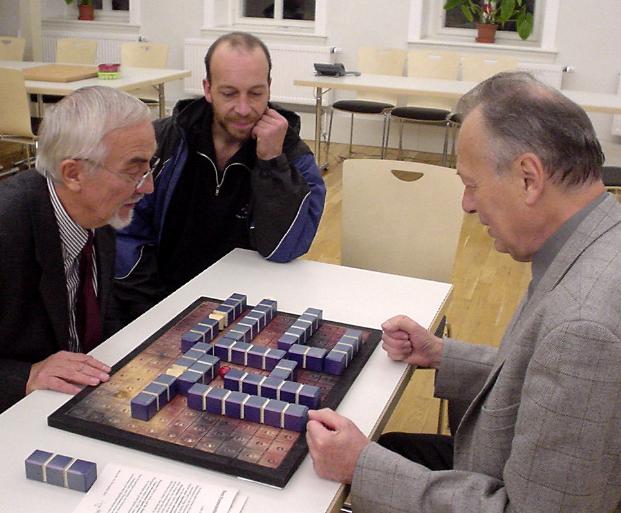
* The game DAWN 11/15 has a predecessor, namely "Ceres and
Gauss - the Goddess and the Mathematician". This game belongs
to the collection "Play Gauss" by Reinhold Wittig and Ingo
Althöfer. Carl Friedrich Gauss was a famous mathematician who
successfully computed the orbit of Ceres.
During the exhibition "Gott würfelt nicht" in Göttingen, in
summer 2005, "Ceres and Gauss" could by played on top of a
large table. See the picture.
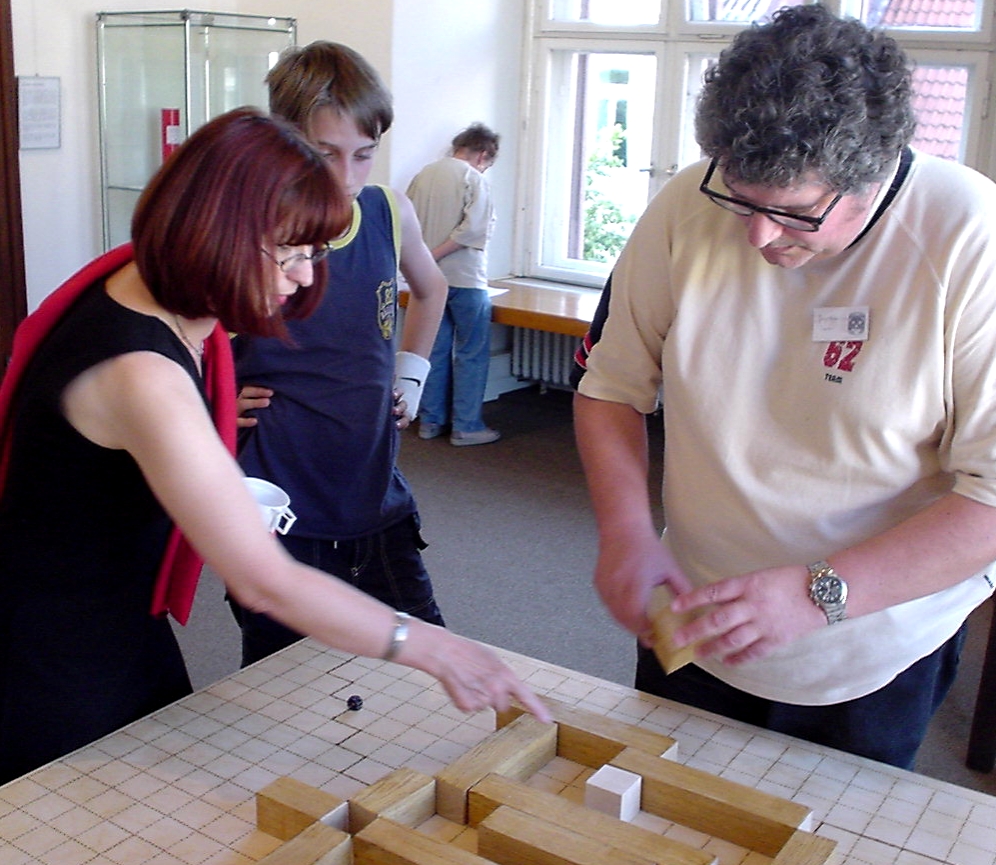
* Sincerest thanks go to Matthias Sick from the "Sam Lloyd AG"
for designing the very nice unique copy of DAWN 11/15! He can be seen
in the middle of the Boerngen-Dorschner picture above.
* Link to the
DAWN mission website
The extended Dawn mission concluded in November 2018. Our game, however,
remains a nice playing ground.
Back to the main site of Ingo Althöfer

 The DAWN bar is jutting out (Other bars are not
allowed to do so.)
The DAWN bar is jutting out (Other bars are not
allowed to do so.)




